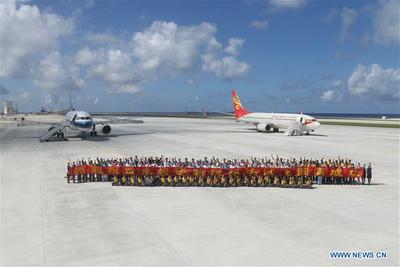| Information |  | |
Derechos | Equipo Nizkor
| ||
| Information |  | |
Derechos | Equipo Nizkor
| ||
06Jan16
Airfield in South China Sea better serves public good

China's testing of a newly-built airfield on Wednesday on Yongshu Jiao, a reef in the South China Sea, is nothing more than an effort by the country to better serve the needs of the great many vessels and seafarers using one of the world's busiest shipping lanes.
The test, with the airport itself signifying a breakthrough in ocean exploration for humankind, calls for a break from the mindset of geographical competition. The airfield would provide benefits due to its convenient location on a reef in the middle of a vast sea, and would also help facilitate maritime research and conservation.
To begin with, China does not even have a need to reaffirm its sovereignty over the island in the way some have claimed since its sovereignty over the Nansha Islands and the adjacent waters has been indisputable and self-evident.
It will by no means undermine the regional peace and stability, either. Instead, it will greatly enhance the safety of the vessels on the vast South China Sea by facilitating search and rescue, disaster prevention and reduction, and research and conservation from a Chinese land base.
Some 100,000 vessels from various countries and regions sail on the South China Sea each year, accounting for about 50 percent of the world's commercial shipping. Safety and security are a concern for those navigating this area, which is known for its rough waters and often aggressive pirates.
When the MH370 flight carrying 239 people went missing in March 2014, it took the rescue vessels and aircraft quite some time to arrive at the places initially believed to be where the flight went missing in the vast sea. A land base like Yongshu Jiao could have significantly reduced the time it took the rescuers to arrive there, experts say.
The first few hours are often critical for maritime search and rescue operations and there are obvious advantages to a land base nearby.
Moreover, records show China has traditionally been charged with providing public services on the Nansha Islands such as radio stations, observatories and lighthouses. Yongshu Jiao, which literally means the reef of eternal summer, saw the establishment of an ocean observatory by China in 1988 as part of an international effort led by the UNESCO.
Over the past 27 years, China has used the observatory, part of the Global Sea Level Observing System (GLOSS), to provide oceanographic and meteorological data to the World Meteorological Organization. Its emergency alert service has made a significant difference, too.
With the airfield on Yongshu Jiao, China can provide what the ships and seafarers need urgently — another lifeline. The Chinese government has made it clear that there would be a runway conforming to civil aviation standards and other upgraded facilities aimed at facilitating search and rescue, disaster prevention and reduction, and navigation safety.
In a break from the mindset of geographical competition, such a land base in the middle of a vast sea would also serve public good by enabling research and conservation efforts that would otherwise be impossible.
China has always upheld and practiced a policy of peace and development. The airfield shouldn't be a cause for concern for anybody. There has never been, and will not be, any problem concerning the freedom of navigation and over-flight in the South China Sea that all countries are entitled to under international law, after all.
[Source: Xinhua, Beijing, 06Jan16]
 | This document has been published on 07Jan16 by the Equipo Nizkor and Derechos Human Rights. In accordance with Title 17 U.S.C. Section 107, this material is distributed without profit to those who have expressed a prior interest in receiving the included information for research and educational purposes. |